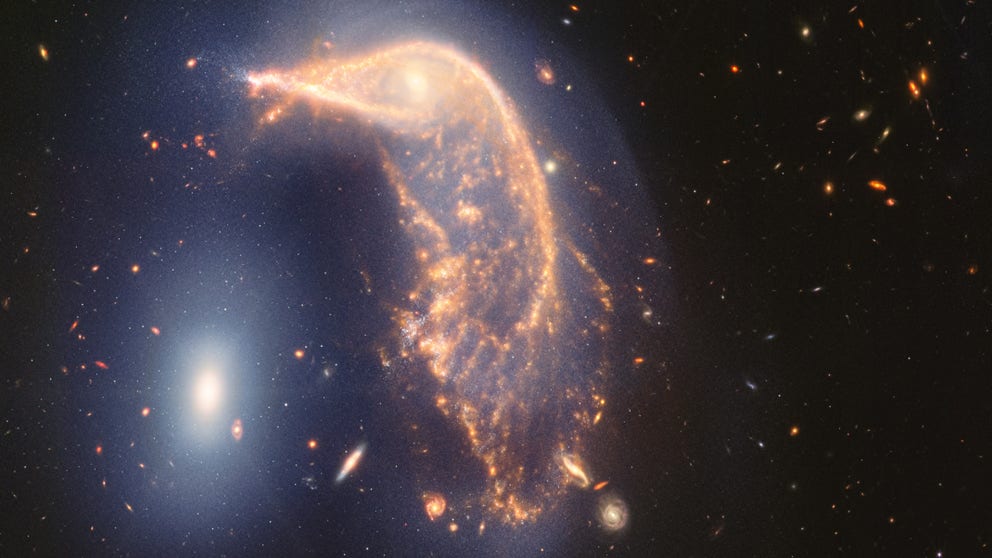'Penguin' and 'egg' galaxy's cosmic dance celebrate James Webb Telescope's 2nd anniversary
NASA released the image Friday to celebrate Webb’s 2-year anniversary, wowing astronomers and stargazers alike with its ability to capture crystal-clear images of some of the universe’s most distant secrets.
What is the James Webb Space Telescope?
According to NASA, the JWST sees the universe using infrared radiation, a form of light that we feel as heat and is invisible to human eyes.
A photo showing two galaxies locked in a slow "cosmic dance" is the latest marvel from the James Webb Telescope.
NASA released the image Friday to celebrate Webb’s two-year anniversary, wowing astronomers and stargazers alike with its ability to capture crystal-clear images of some of the universe’s most distant secrets.
The two galaxies are known as Arp 142 and sit some 326 million light-years from Earth. The two galaxies first mingled between 25 million and 75 million years ago when the "penguin" shaped galaxy (known as NGC 2935) and the more compact "egg" galaxy (NGC 2937) first passed through each other, setting off a complex gravitational dance.

These images of Arp 142 are a composite of separate exposures acquired by the James Webb Space Telescope using the NIRCam and MIRI instruments.
(NASA, ESA, CSA, STScI / NASA)
"They will go on to shimmy and sway, completing several additional loops before merging into a single galaxy hundreds of millions of years from now," NASA’s Webb Mission Team wrote.
WHO WAS JAMES WEBB? THE NAMESAKE BEHIND THE SPACE TELESCOPE
NASA astronomers said before the two galaxies collided, the "penguin" galaxy had a more traditional shape of a spiral, but now its center gleans like the penguin’s eye with the part of the galaxy now unwound and fanned out into the penguin-like shape Webb sees today.
"Cosmic Dance" between two galaxies celebrates James Webb telescope's 2 years in service.
This video tours Arp 142, an interacting galaxy pair affectionately known as the Penguin and the Egg that lies 326 million light-years from Earth. (Video courtesy: NASA)
"The galaxies’ ‘dance’ gravitationally pulled on the Penguin’s thinner areas of gas and dust, causing them to crash in waves and form stars," NASA wrote.
Meanwhile, the "egg" shaped galaxy remains close to its original shape, as it is an elliptical galaxy filled with aging stars, but a lot less gas and dust to be pulled away and distorted, NASA said.

Galaxy Arp 142 is shown both from the Hubble Telescope (left) and from the James Webb Telescope (right)
(NASA)
The "egg" also has roughly a similar mass to the "penguin" galaxy, and is another reason the egg’s shape wasn’t consumed by the penguin galaxy.
STUNNING IMAGES, DISCOVERIES FROM JAMES WEBB SPACE TELESCOPE IN 2023
According to NASA, the two are about 100,000 light years apart — quite close in astronomical distances. For reference, NASA said that our Milky Way Galaxy’s closest neighbor is the Andromeda Galaxy at about 2.5 million light years.
Some day, some distant observer may watch our own galaxy head to the astronomical dance floor. Milky Way and Andromeda are expected to eventually meet up, but not for about 4 billion years. (If you can’t wait that long, NASA has a handy video visualizing the future dance.)

